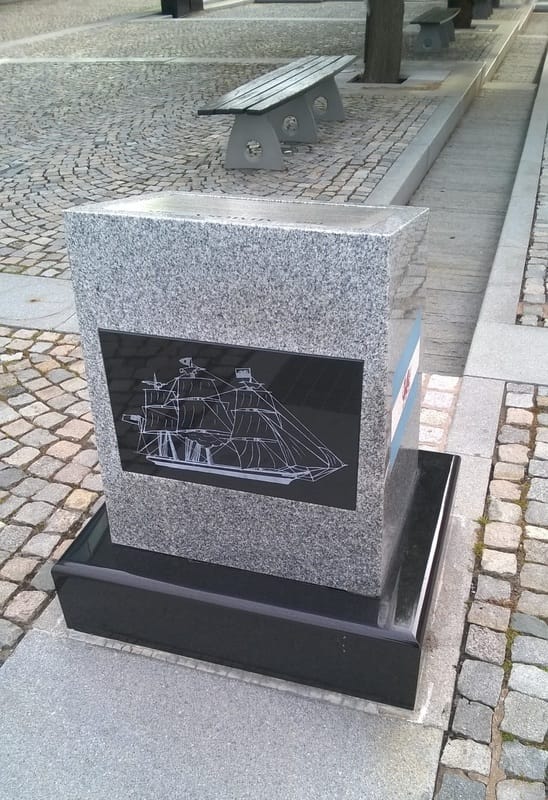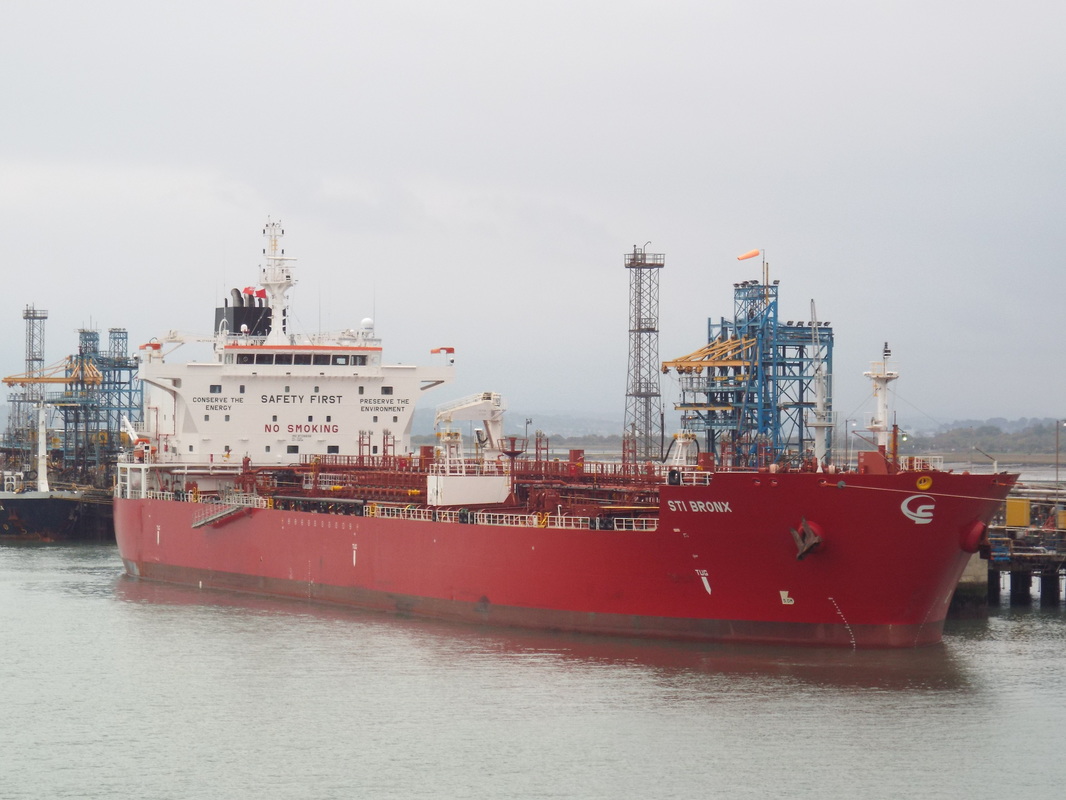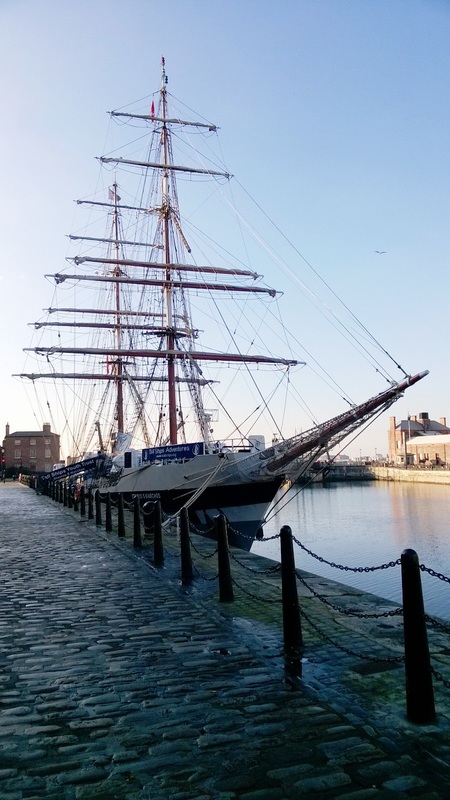She was built in 1985 and is 12.9m long with a GT ofn 16.1 and is powered by a 127kW engine.
|
Littlehampton registered fishing vessel Mayfly photographed in Portsmouth on 27 October 2015.
She was built in 1985 and is 12.9m long with a GT ofn 16.1 and is powered by a 127kW engine.
0 Comments
I took this photo on 6 July 2016. Having seen the memorial a few times and after reading the brass plaque I decided to do a bit more research.
In May 1865 the tea clipper Mimosa was in Liverpool's Clarence Graving Dock being fitted out for a voyage to carry Welsh emigrants to Patagonia in South America. Mimosa was at the time 12 years old and not apparently the first vessel of choice. The vessel Halton Castle which was better equipped to carry passengers was to have taken the voyage in April 1865 but for some reason was still at sea and a such unavailable. Within the hold partitions were constructed to separate the men's sleeping quarters from the women's and the areas were fitted out with tables, benches and other items for the passengers. The cost of fitting, provisioning and chartering Mimosa was £2,500. The fare for adults was £12 and £6 for children, although. The duration of the voyage was uncertain and provisions sufficient for a six month voyage were stored. Mimosa's Captain was George Peperell and he assembled a crew of 18 which was a larger one than than needed for carrying only cargo. Most of the crew were from Liverpool with two sailors from a Swedish ship and another from a Portuguese vessel. Upon discovering that his passengers were almost all solely Welsh speaking the Captain signed on a young Welshman called Richard Berwyn as purser (Richard later became the first school teacher of the colony). Because, by law, a doctor was required for any ship carrying more than fifty passengers, a young doctor from Ireland called Thomas Greene, who had just completed his medical studies and who was looking for a medical position overseas was signed on as ship's surgeon. The passengers numbered 153 and came from all parts of North and South Wales. There were 56 married adults, 33 single or widowed men and 12 single women who were either sisters of married passengers or servants, the remainder were children or babies. Mimosa left Clarence Graving Dock on 25 May 1865 and was towed into Victoria Dock, a few days later on 28 May1865 she left the River Mersey and headed out into the Irish Sea. The journey took 65 days and despite the daily issue of lime or lemon juice as a precaution against scurvy, many of the passengers began to suffer from boils and bleeding gums. The conditionas below decks particularly in the tropics was appalling Five children died on the voyage and two babies were born. A widow and widower were married sortly after leaving Liverpool. At a Brazilian port where they stopped to replenish provisions the Captain tried unsuccessfully to persuade the passengers to disembark to join a colony already established in Brazil. As Mimosa sailed further south they encountered the cold of the South Atlantic. On clear days columns of vapour could be seen far out to sea. The thought of steamships sailing so far south was a comfort to the passengers that their destination was not as isolated as they had been led to believe. It was the mate who realized that the "smoke" was not from steamships, but from whales. Finally, just before dawn on 27 July 1865 Mimosa reached her destination and dropped anchor in a natural harbour comprising a semi-circle of rocks, some 8 miles wide and 22 miles in length. Most of the passengers dressed in their best clothes were on deck before dawn. At about one o'clock in the afternoon there was a gunshot from shore and by late afternoon Lewis Jones and Edwyn Roberts rowed out to where Mimosa was anchored and came on board. Disembarcation took more than a day as the passengers had to be rowed to shore along with their possessions which included farm implements and pieces of furniture. The ship's cook elected to remain with the colony and left the ship. On the next day everyone gathered on the beach. A short sermon of thanks was held and the place where they stood was named Port Madryn after Madryn Castle on the windswept Llyn Peninsular in North Wales. Little is known of Mimosa after her voyage to Patagonia except that in the following year the entire crew mutinied over short rations and Pepperell was incarcerated on board. What became of her is not known. STI Bronx photographed at Fawley on 24 October 2015.
Built in 2015 by SPP Shipbuilding in Sacheon, South Korea as yard number s1167 her overall length is 183.07m with a 32.3m beam and 13.315m draught. NT = 13,834, GT = 29,735 & DWT = 50,135. She is powered by a 6 cylinder Sulzer-Wartsila 6S50MC-C 12,890 hp marine diesel engine giving a top speed of 14.9 knots. She is operated by Scorpio Tankers Inc who have executive offices in Monaco and New York, they are a provider of marine transportation of petroleum products worldwide. MMSI - 538005418 REG - MH, Majuro IMO - 9706841 Call Sign - MV7DQ4 Chemical / Oil Product Tanker Built - SPP SB Co, Sacheon, KR Yard Number - s1167 L = 183.03m W = 32.2m GT = 29735 Year - 2015 Fawley, 24 october 2015 Sail Training vessel Stavros N Niarchos photographed near the Albert Dock in Liverpool on 14 November 2014.
The ship was built in Appledore in 2000 on a hull that had been constructed in Germany. The naval Architects were Burness, Corlett and Partners and the rig was designed by sail training expert Michael Willoughby. The vessel has ten square rigged sails, seven staysails and a spanker giving a a total sail area of 949m2. Both masts have steel lowers and timber top masts reaching 36.5m above the water. Accommodation is provided for 67 in 5 double, 6 single 1 three berth and 6 dormitories with 8 pipe-cot berths. She has two deck houses, one containing the wheelhouse, masters cabin and wardroom, the other containing the galley, pantry and mess room which provided service for 48 people. Two 333kw Mercedes MTU auxillary engines power the brig to 9 knots via two controllable pitch propellers.She also has a single 90kw bow thruster. The hull is divided into six watertight compartments. GT = 493 and NT = 198 At the time of writing she is up for sale in the commercial market for £2.95m. MMSI - 232007330 REG - UK, London IMO - 9222314 Call Sign - MZIU7 Sail Training Ship Built - Abeking & Rasmussen, lemwerder, DE (Hull only) Yard Number - 6442 L = 59.33 W = 9.88 GT = 493 Year - 2000 Liverpool, 14 November 2014 Port of Liverpool painted by Samuel Walters (1811–1882) in 1836.
This painting depicts a number of sailing vessels battling against a northerly gale on the River Mersey. To the left is the John Bagshaw and on the right is the anchored Maria Brandt whose crew are frantically trying to salvage a lost mast amongst the waves. In the distance can be see paddle steamers and other sailing vessels near Princes Dock on the left and the masts of numerous vessels in Georges Dock on the right. The church and tower of St.Nicholas can also be clearly seen. Samuel Walters was born in London. His father was also a maritime artist and while he taught Samuel, Samuel was largely self-taught. Samuel moved to Liverpool and began to exhibit work in 1830. He became a member of the Liverpool Academy of Arts in 1841. He had work exhibited at the Royal Academy from 1842 to 1861 and also lived in London from 1845 to 1847, before returning to Liverpool to live in Bootle. Photographed in Liverpool on 2 May 2015. Artist John Mansbridge painted this mural in 1951 for the officers lounge on the Blue Funnel liner Ixion.
When Alfred & Philp Holt began naming ships of the Blue Funnel Line they chose to take names from the Odyssey and Illiad. Within the mural Britannia has the face of MrsHolt who launched the vessel and Neptune has the likeness of her husband Lawrence Holt. John Mansbridge (1901 - 1981) was an official war artist during the Second World War and was attatched to the Air Ministry. He later worked on developing camouflage. He was head of fine art at Goldsmiths College. Photographed in LIverpool 2 May 2015 |
AuthorMy interest in ships and the sea started back in 2006 when I worked for a couple of years on the banks of the River Mersey. I have since been on a couple of cruises around the Med and in the Far East and have started to take more interest in researching and photographing some of the ships and other vessels seen on my travels. Archives
February 2019
Categories |








 RSS Feed
RSS Feed
